
You are reading the older HTML site
Positive Feedback ISSUE
may/june 2008
origin live
the Illustrious Mk III tonearm:
No
Uncertain Voice
as reviewed by Bruce Kinch
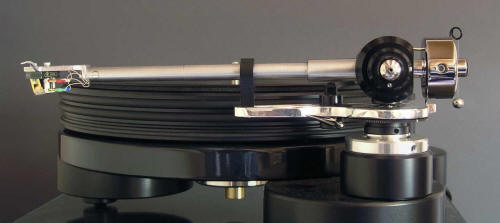
|
Tonearm. Explain that one to the iPod generation. Along with its etymological cousins—the album, the platter, the needle, the turntable, the speaker—it's an oddball term surviving from the pre-electric, pre-electronic, pre-digital days when the threads of musical culture were spun at 78 rpm. The irreducible basis of analog (with a ue in the UK) audio is that the sensation of sound can be reproduced mechanically, as was early impressed upon me when a thumbtack pressed through a Dixie-cup was applied to a revolving rendition of Rudolph the Red Nosed Reindeer.
The gramophone's "needle" was mechanically linked to the "reproducer", a diaphragm that vibrated in response to the modulations the needle followed in the groove, just as the bottom of the Dixie-cup did. The early tone-arm thus had two functions, which explains the hybrid nature of the word. As remains today, the "arm" had to swing freely to allow the needle to follow the groove. However, the tubular device was also the acoustic link to the horn speaker; as the word implies, its ability to transmit the faint micro-vibrations was crucial to the quality of "tone" produced by the player.
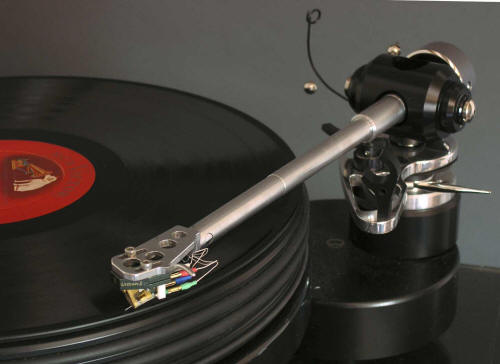
Enter electricity. Some marketing type renamed the needle a stylus (fortunes were lost when the market in cactus futures collapsed), and the reproducer was replaced by itty-bitty ceramics, magnets and coils that could generate a wee bit of electricity when wiggled by the cantilever that linked them mechanically to the stylus tracing the groove. With the advent of the 33 rpm microgroove LP, the "swing freely" notion of tonearm design became paramount. But the second aspect of the device—the mechanically transmitted vibrations that affected "tone"—never really went away. Unfortunately. Even today, if I lower the stylus into a spinning groove with the rest of the system off, I can still hear the whispering ghost of Gene Autrey go down in history.
That "needle chatter" is mechanical vibration and resonance. It is not just audible; it is transmitted to and reflected back from the vinyl (thus the "sound" of different platter mats and clamps), and also from the cartridge body through the tonearm, arm-board, chassis, spindle, platter, and ultimately back to the stylus. Such secondary vibration and resonance can activate the ultra-sensitive stylus, and add coloration to the sound. You can hear these resonances when the stylus drops in a groove or ticks over a fine scratch or thuds over a pressing bubble. Which is one reason why tonearm design, more than anything else in audio, is largely a matter of mechanical engineering and materials science.
The "arm" aspect is basic geometry. Linear tracking arms aside, all tonearms require the stylus to be a certain distance from the pivot and offset a specific angle to minimize tracing distortion. Success in the market place has resulted in some de-facto standards: SME, Linn, and Rega geometries have been widely adopted by other manufacturers. Rule Brittania. Secondary geometrical factors include azimuth (stylus being vertical from the front), and VTA. But really, the "arm" aspect is rather straightforward compared to dealing with the "tone". While you can find survivalist-chic information on the net on making your own tonearm from balsa wood and sewing needles, serious tonearm design has advanced remarkably since the "Death of the LP" was first reported some 25 years ago.
Which brings us to Origin Live. UK based, OL doesn't actually seem to have a distributor in the US, but their products are readily available from independent dealers, direct, and on the net through sources like Audiogon. Given this low profile Stateside, OL is known to most US audiophiles for two things. First, for devising a DC motor retro-fit system for the many audiophile turntables that employ vibration-prone AC motors. And mostly, for being the first (of now several concerns) to re-wire and structurally modify the ubiquitous Rega RB 250/300 tonearms. The basic Rega arms are silly-good for the price, and have basically owned the low-to-midprice tonearm market. Upgrading them makes good sense as there are not a lot of options out there before you get to Graham, Tri-Planar, SME, or Schroeder territory.
Except from Origin Live. Yes, they do still offer a modified Rega arm—the OL-1 ($800 on Audiogon, fully tricked out). But few on this side of the pond realize OL has a stable of six tonearms, all sharing the Rega geometry, but precious little else of Roy Gandy's design. In fact, several are now in Mk III versions. The OL approach evolves as the price point rises: the Silver (£599/$1050), Encounter (£970/$1680), Illustrious (£1770/$3000), Conqueror (£2500/$4285), and the Enterprise (£4500/$7700). Hey, they have a full range of turntables too, but that's for another time. For more information, poke around their very informative website.
Under discussion right now is the Illustrious Mk III. Here in the colonies that might seem an odd name, but the better OL arm designations honor warships of the Royal Navy—there have been five to bear the proud name HMS Illustrious. The ship's motto is Vox Non Incerta, which translates as "No Uncertain Voice". Not a bad slogan for a tonearm, either. When I first expressed interest in getting in a review sample, Mark Baker, head guy at OL, demurred, as MK II was about to be replaced. There are several changes, most visible being that the main tube now has three stepped diameters, i.e., not uniform all along as with the Encounter. Also, the arm-rest support is heavier, and is now chrome plated. But the most significant element of the MK III version is the dual pivot bearing for vertical arm movement. Most tonearms (leaving aside suspended designs like the Schroder and Well-Tempered) are either unipivot or conventional gimbaled designs, each with advantages and limitations. As OL puts it, the very low friction unipivots excel at transparency and detail, but can have problems in the bass, as keeping the azimuth steady gets "fiddly". Conventional bearings that are too tight can have too much friction, and if too loose lead to bearing chatter. And good bearings can be expensive.
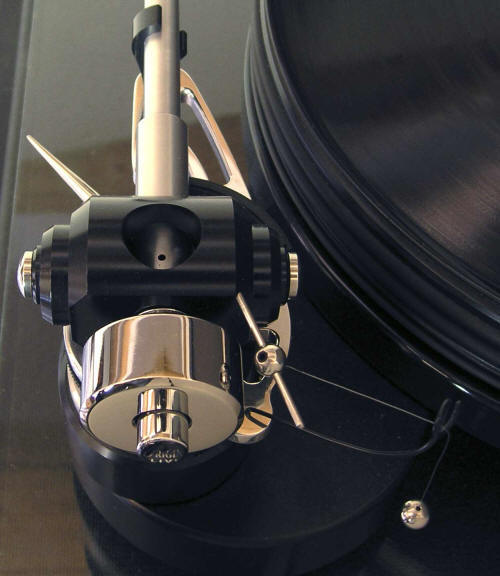
The Illustrious design is functionally similar to that employed in the Mørch DP-6. Horizontal rotation is by a conventional bearing, while vertical movement is via two point-in-jewel cup bearings—but where the Mørch has the bearings points down, the OL works points up, and with the bearings more widely spaced for stability. And unlike the Danish design, the "floating" OL bearings are captive in a massive yoke (i.e., the wand is not removable). This creates increased inertia in the horizontal plane, but minimizes it in the vertical. The idea is to get the high frequency resolution and tracking of a unipivot with the weight and drive (and bass extension) of a conventional bearing. Although the arm can be lifted a millimeter or two off the bearing, it is mass-loaded, self-centering and stable in use—no bearing chatter at all. As two points define a line, one suspects Baker also looked at the knife bearings of older SME tonearms that still have a devoted following. And to be fair to cat-skinners everywhere, both the Basis Vector and the Graham Phantom are current US designs that seek to stabilize a unipivot (in different ways) for pretty much the same reasons.
Other key priorities of the OL approach are an emphasis on rigidity and resonance suppression. The Illustrious headshell is machined from a high-strength alloy to minimize the microscopic twisting and flexing that OL says has been revealed by holographic analysis of many headshell designs. Not a simple mounting plate, it incorporates anti-torsion side supports, anti-resonance openings that lower the overall mass, and a minimal contact area with the cartridge. The stepped diameter armtube lowers the effective mass while increasing rigidity and suppressing resonances. Baker emphasizes that the vibrations a tonearm must deal with (from both the stylus and external sources) are not simple up/down, back and forth impulses, but chaotic, rippling micro-vibrations and torsional stresses. In this regard, he feels the floating dual pivot combined with rigid arm and headshell is mechanically superior to either unipivot or conventional bearings.
Origin Live also departs from Rega-World when it comes to VTA adjustment. Actually, the Brits have never been particularly keen on VTA, which I always assumed was a conditioned reflex from the close-cognate VAT. Well, the better OL arms now have integral VTA adjustment.
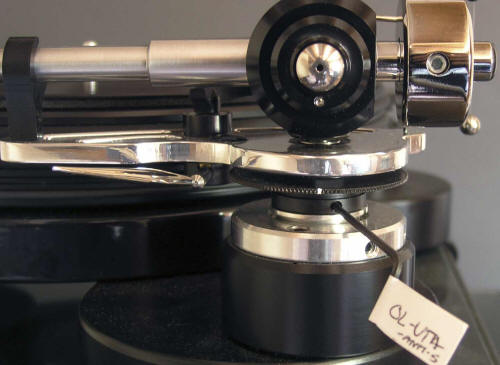
A thin serrated flange at the base of the arm pillar raises and lowers the arm when rotated. Records can be played while adjusting it, but an Allen head grub screw must be tightened for best sound. A welcome feature to be sure, but don't expect micrometer-precision readout; there is simple notch on the flange so you can count the revolutions. If you are the kind of audiophile who has to tweak VTA on the fly twice for every disc, stop reading this and go buy a VPI or Graham. Personally, until I can sit in the sweet spot and crank an arm up and down with a wireless remote, I'll continue to re-set VTA as needed with an adjustable jig I devised years ago—and the Origin Live system is perfect for that. Finally, given that OL led the re-wire-your-Rega rage, it is worth noting that they use some excellent but idiosyncratic lead out cabling—more on that below.
The Version III tonearm did eventually arrive, securely packed in a wooden box. Also included are an alignment protractor, a simple "seesaw" stylus gauge, and a set of Allen wrenches for set-up and adjustment. And, mirabile dictu, a burn-in cable! The minuscule output of MC cartridges can never properly burn in even the delicate internal litz wiring, so OL cheats in pursuit of optimal performance. What you get are some cheapo RCA interconnects with the plugs on one end removed. Soldered in their place are short bits of maybe 12 gauge solid core. You simply plug the RCAs into a line level source like a CD player and attach the cartridge tags to the wire ends. You then plug the tonearm RCAs into your preamp, insert a loud and thrashy CD, push play and repeat, and come back in a couple of days.
The fit and finish of the Illustrious is quite good, but not Asian-obsessive. It is more massive than one might expect, making a RB300 look and feel like a toy.
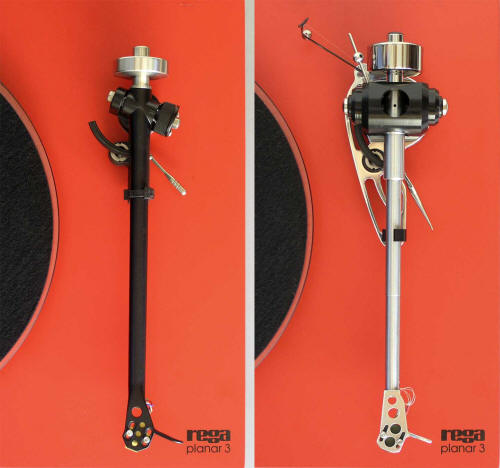
At 820g it's nearly twice as heavy, something to keep in mind if you have a suspended sub-chassis deck (OL provided a dedicated armboard for the Linn). The heft and metal work evoke that of a fine firearm, and in an odd way, viewing it in profile—stepped barrel and circular yoke—almost suggests the classic lines of a Luger P 08. Setup is straightforward because of the geometry—any Rega arm mount makes it a drop-in substitution. One bitch: every grub screw one loosens or tightens seems to require a different size Allen wrench. They are supplied, but if I hadn't put tape labels on them, I'd have had no clue which to stick where.
Even so, I immediately managed to mess things up. Mark Baker's Origin Live turntables tend toward the lightweight acrylic platter, minimal plinth, DC motor school. Rather than just swap out the RB300 on my Planar 3, I decided to mount the Illustrious on my Nottingham Analogue Spacedeck, which is a very different take on what makes a good turntable. I have no idea if Baker and Tom Fletcher have ever hoisted a pint together, or if this was akin to wearing a Manchester United jersey in Liverpool. Visually, the combination looked terrific, as both convey a no-frills seriousness to the task at hand. So I cued up some Chopin, sat back, and hit the phono input on the remote.
What I heard was not just Rubinstein; Rush Limbaugh was carrying on about feminazis, li'bruls, and how well the war was going, despite what the drive-by media keeps putting on the 6 o'clock. Talk about RFI hell. It took a few emails back and forth across the Atlantic to figure out what was going on. It was mid-summer here in the desert, and to beat the heat I had replaced my Herron tube phono stage with the solid-state Aqvox II CI, largely on the recommendation of PFO colleague John Zurek (here is a link to his PFO review). While I can enthusiastically second everything he wrote about it, due to the unique circuit design and RCA to XLR adaptors, it is fussy about the phono cabling. On the Aqvox site there is a list of tonearms that have checked out fine with their system. Stock Regas are not suitable (no separate ground lead) but rewired ones are—my Incognito rewired RB250 had not had any problems at all. Just about every other tonearm imaginable makes the OK-list—except Origin Live.
Recall I had mentioned that Origin Live utilized a unique lead-out cable. They allude to its superiority on their site, but give no details. It turns out that, while 99% of the phono cables out there use twisted pairs, spirals, or braids, OL uses co-ax—that is, the outer screen carries one leg of the circuit. Baker made that choice, like every other aspect of his design, for purely sonic reasons. With a single-ended (RCA) input phono stage, the screen helps lower the noise floor by taking RFI to ground. With the balanced input Aqvox, the screen became an antenna. Ooops. There was an easy fix—I wrapped the cables with foil, and connected that to the Aqvox ground post, and Rush retreated to his rat-hole. Ugly, but the sound was now excellent—the cable is indeed quite fine—but Baker asked that I return the tonearm so he could be sure nothing internal was amiss.
Not long after that, another wooden box arrived from OL, another Illustrious with of all things, a standard 5 pin "DIN" socket in the arm pillar, and a DIN to XLR cable. These options were not on the OL web-site before I managed to get Mark at OL and Norman at Aqvox equally exasperated, but they are available now. So, if you want to put a Kimber or Hovland (I am blessed with both) or whatever cable on an Origin Live arm, you can do so. Conversely, if you have known or possible RFI problems and/or a single ended (RCA plugs) system, the stock OL co-ax will be just the ticket. One of the advantages of small-firm sourced products is flexibility in meeting customer needs. Assuming the substitute OL cable was a one-off accommodation and not a standard item, most of my listening with the Illustrious and Aqvox was done with the very fine Xaus Phono from Zu Cables, terminated by those kind folks exactly as recommended by Aqvox. Come the cooler months, I switched back to the single-ended, tube-based Herron Audio gear with the Kimber and Hovland cables. Brilliant!
Having the whole kit up and running, I was ready for some serious listening. Unfortunately, I don't have a pile of super arms, tables, or cartridges lying around for comparison, but it was easy to put the "just an upmarket Rega" knock to rest. On my Planar 3, my Incognito wired/Expressimo weighted RB250 (the rough equivalent of an OL-1) is clearly superior to the stock RB300. The Illustrious totally outclasses either. The Illustrious lets the Planar 3's virtues shine—plenty of PRAT (Pace, Rhythm, and Timing)—while smoothing out the occasional edginess, providing a sense of much more secure tracking at the frequency extremes, and opening up the imaging significantly. Point taken: while few arms of this class will end up on a Rega 3, money spent upgrading the tonearm on even a budget deck can be more effective than a pricey cartridge on a stock arm.
Origin Live's design emphasis suggests a corollary to Ivor's Adage that the turntable is the most important component: The tonearm must stabilize the cartridge platter interface without adding or subtracting information, or neither turntable nor pickup can perform optimally. In other words, the better the tonearm, the less audible will be its sonic signature, and the less it will interfere with the characteristics of turntable and cartridge.
This proposition was quite apparent on the much more massive Nottingham Spacedeck. True, my Mørch UP-4 unipivot has always given a good account for itself, but the Illustrious trumps it in virtually every respect. True, with the UP-4 you can fiddle with the damping, worry about the azimuth, and swap out armwands to match different cartridges. Actually, you pretty much have to, because all will affect the sound. By contrast, setting up the Illustrious is quite straightforward. As with the Mørch there is a small hole in the yoke for pivot-locating protractors like the Dennesen and Feickert.
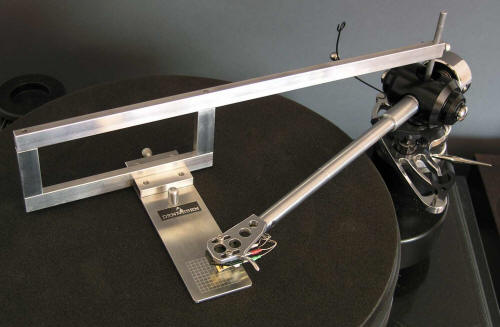
At 14.5 gr. effective mass, the Illustrious is roughly equal to the heaviest Mørch wand (the Mørch design hails from the high-compliance MM/low mass arm era). That's about ideal according to the math for many MC cartridges like my Denon 103 and Lyra Lydian Beta, but I really had no problems with higher compliance Grado or Empire EDR.9 MMs either. I also dusted off my vintage Fidelity Research and Supex carts that just loved the Illustrious—the arms I had back in the day clearly never did them justice. I do have a couple of quibbles with the OL ergonomics, however. The weight and thread anti-skate is un-calibrated. The arm rest does not have a secure grip or lock on the arm tube, so it can swing about if even lightly bumped. OL recommends twisting the cradle a bit so the tube "clips" into place. I added a bit of sticky-backed foam instead to help secure the arm. I also thought the cuing lever gets too close (1/8") to the bearing yoke in the "up" position—it is much too easy to hit the housing when operating it.
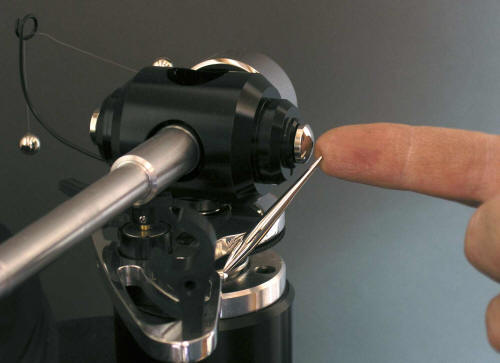
The cuing mechanism can be rotated for better clearance by loosening the grub screw if you are as much a bumblethumb as I am.
No quibbles at all about the sonics, though. The Spacedeck brings a weight to the musical argument that eludes the Rega—not more bass, but rather increased density of tone throughout the spectrum. The Illustrious built on this characteristic and balanced power with nuance and subtlety. Music just flows as in a real performance—in tune, in time, in place. Given a cartridge and recording capable of it, the combo presented a soundfield remarkably deep and wide. On the Wendy Carlos Sonic Seasonings synth extravaganza, for example, there were stable images 180° off axis and above the ceiling line. On well-done recordings made in real acoustic space, image resolution of individual instruments and voices was exemplary: in scale, and distinct but neither edgy nor foggy. On vintage RCAs it was fascinating to hear how differently the Boston, Chicago, and Decca-recorded London orchestras inhabit their halls—ambience cues were quite abundant.
Presentation of both voice and instrument was particularly natural sounding—except when processing and reverb were all too obvious. Piano had very realistic attack, sustain, and decay. Bass was deep, clean, and tuneful. Voices were richly textured throughout their range, the mid-range neither recessed nor given to honk and screech. Dynamics were superb, no leading edge overemphasis or overhang, no muddle when things get complex, and plenty of startle when called for. Incredible detail resolution that was consistent throughout the frequency and dynamic ranges. In short, thoroughly articulate without any sense of exaggeration or coloration, although the individual characteristics of a given recording, cartridge, platter mat, etc. were preserved. There was a notable lack of sibilance and tizziness, and the way the Illustrious dealt with surface noise gave another indication of the arm's non-resonant character. Groove noise was quite low, and whenever tics, thumps, and pops would occur, the Illustrious recovered from the transients gracefully, the musical line rarely seeming disrupted. No matter what I put on the platter, the Illustrious sailed through unperturbed. Some tonearms almost seem to be wind-surfing the winding groove—and some listeners do find incipient mistracking exciting; the Illustrious is by comparison a swift but stable catamaran effortlessly skimming the waves. It's a quality that sneaks up on you—the absence of misbehavior that makes you forget about hi-fi and just engage the music. And then the side ends, and you realize you are in a state of exhilaration. That is analog (ue)!
Audiophiles are enjoying a second Golden Age of vinyl replay of late, but the enthusiast market remains small. Precision engineering and low-volume production gets expensive fast, especially for imports—the Geniuses in Charge have done the dollar no favors in the 21st Century. Although Origin Live has more expensive models, there are very few apparent compromises in the Illustrious—indeed, the Mk I version was called a world-beater in UK reviews less than five years ago. The Conqueror and Enterprise have followed to further raves, the differences in the dearer models including even higher-spec bearings, superior armtube damping and Eichmann RCAs (and presumably a few things they don't tout in the literature). I suspect the Mk III Illustrious is now the value-for-money sweet spot in the lineup, and if not the world's best, it is certainly world class. As noted, it will not appeal to the audiophiliac who is compelled to endlessly fiddle and adjust everything. Rather, it is an elegant—and addictive—solution to extracting music from vinyl. Combining the sonic virtues of both unipivot and gimbaled bearings in a fuss-free package, it should work exceedingly well with a wide variety of cartridges and turntables. It is certainly the best all-around tonearm I've ever had in my own system. Highly recommended! Bruce Kinch
Origin Live Ltd
Unit 5, 362B
Spring Road
Sholing,
Southampton
UK SO19 2PB
web address:
http://www.originlive.com
